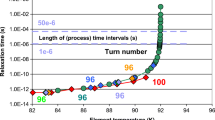Abstract
The formation of thermal and electrodynamic states in Bi2Sr2CaCu2O8 under the condition of current input is studied. The analysis is carried out for partial and complete current penetration under the assumption that the superconductor is cooled down to liquid helium temperature at the zero time. When the current input is continuous, the temperature dependence of the Bi2Sr2CaCu2O8 specific heat influences the form of the I-V and I-T characteristics of the superconductor. This effect is observed at high electric fields when both stable and unstable states form. As a result, the nonstationary I-V characteristic of Bi2Sr2CaCu2O8 has the only branch the slope of which is positive and decreases with increasing temperature. Therefore, the higher the rate of current input, the more pronounced the decrease in the slope. It is concluded that one cannot find the current above which instability develops from the Bi2Sr2CaCu2O8 I-V characteristic if the current input is continuous.
Similar content being viewed by others
References
M. S. Newson, D. T. Ryan, M. N. Wilson, and H. Jones, IEEE Trans. Appl. Supercond. 12, 725 (2002).
K. Watanabe, S. Awaji, and M. Motokawa, Physica B 329–333, 1487 (2003).
R. H. Bellis and Y. Iwasa, Cryogenics 34, 129 (1994).
V. R. Romanovskii, Zh. Tekh. Fiz. 70(5), 47 (2000) [Tech. Phys. 45, 1557 (2000)].
V. R. Romanovskii, Cryogenics 42, 29 (2002).
V. R. Romanovskii, Zh. Tekh. Fiz. 73(1), 55 (2003) [Tech. Phys. 48, 52 (2003)].
A. Junod, K. O. Wang, T. Tsukamoto, et al., Physica C 229, 209 (1994).
P. F. Herrmann, C. Albrecht, J. Bock, et al., IEEE Trans. Appl. Supercond. 3, 876 (1993).
M. Polak, I. Hlasnik, and L. Krempasky, Cryogenics 13, 702 (1973).
S. S. Kalsi, D. Aized, B. Connor, et al., IEEE Trans. Appl. Supercond. 7, 971 (1997).
H. Kumakura, H. Kitaguchi, K. Togano, et al., Cryogenics 38, 163 (1998).
H. Kumakura, H. Kitaguchi, K. Togano, et al., Cryogenics 38, 639 (1998).
T. Kiss, V. S. Vysotsky, H. Yuge, et al., Physica C 310, 372 (1998).
A. L. Rakhmanov, V. S. Vysotsky, Yu. A. Ilyin, et al., Cryogenics 40, 19 (2000).
G. Nishijima, S. Awaji, S. Murase, et al., IEEE Trans. Appl. Supercond. 12, 1155 (2002).
G. Nishijima, S. Awaji, and K. Watanabe, IEEE Trans. Appl. Supercond. 13, 1576 (2003).
Author information
Authors and Affiliations
Additional information
Original Russian Text © N.A. Lavrov, V.K. Ozhogina, V.R. Romanovskii, 2008, published in Zhurnal Tekhnicheskoĭ Fiziki, 2008, Vol. 78, No. 4, pp. 76–81.
Rights and permissions
About this article
Cite this article
Lavrov, N.A., Ozhogina, V.K. & Romanovskii, V.R. Low-temperature formation of thermal and electrodynamic states in Bi2Sr2CaCu2O8 . Tech. Phys. 53, 466–471 (2008). https://doi.org/10.1134/S1063784208040129
Received:
Published:
Issue Date:
DOI: https://doi.org/10.1134/S1063784208040129




